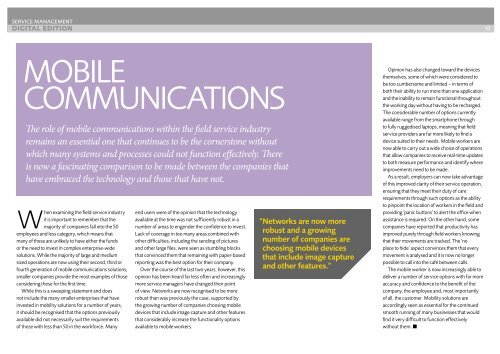Service Management Buyers Guide 2010 - daruMath
Service Management Buyers Guide 2010 - daruMath
Service Management Buyers Guide 2010 - daruMath
You also want an ePaper? Increase the reach of your titles
YUMPU automatically turns print PDFs into web optimized ePapers that Google loves.
SERVICE MANAGEMENT<br />
Digital EDition 10<br />
MObIlE<br />
cOMMunIcATIOnS<br />
The role of mobile communications within the field service industry<br />
remains an essential one that continues to be the cornerstone without<br />
which many systems and processes could not function effectively. There<br />
is now a fascinating comparison to be made between the companies that<br />
have embraced the technology and those that have not.<br />
W<br />
hen examining the field service industry<br />
it is important to remember that the<br />
majority of companies fall into the 50<br />
employees and less category, which means that<br />
many of these are unlikely to have either the funds<br />
or the need to invest in complex enterprise-wide<br />
solutions. While the majority of large and medium<br />
sized operations are now using their second, third or<br />
fourth generation of mobile communications solutions,<br />
smaller companies provide the most examples of those<br />
considering these for the first time.<br />
While this is a sweeping statement and does<br />
not include the many smaller enterprises that have<br />
invested in mobility solutions for a number of years,<br />
it should be recognised that the options previously<br />
available did not necessarily suit the requirements<br />
of those with less than 50 in the workforce. Many<br />
end users were of the opinion that the technology<br />
available at the time was not sufficiently robust in a<br />
number of areas to engender the confidence to invest.<br />
lack of coverage in too many areas combined with<br />
other difficulties, including the sending of pictures<br />
and other large files, were seen as stumbling blocks<br />
that convinced them that remaining with paper-based<br />
reporting was the best option for their company.<br />
Over the course of the last two years, however, this<br />
opinion has been heard far less often and increasingly<br />
more service managers have changed their point<br />
of view. networks are now recognised to be more<br />
robust than was previously the case, supported by<br />
the growing number of companies choosing mobile<br />
devices that include image capture and other features<br />
that considerably increase the functionality options<br />
available to mobile workers.<br />
“Networks are now more<br />
robust and a growing<br />
number of companies are<br />
choosing mobile devices<br />
that include image capture<br />
and other features.”<br />
Opinion has also changed toward the devices<br />
themselves, some of which were considered to<br />
be too cumbersome and limited – in terms of<br />
both their ability to run more than one application<br />
and the inability to remain functional throughout<br />
the working day without having to be recharged.<br />
The considerable number of options currently<br />
available range from the smartphone through<br />
to fully ruggedised laptops, meaning that field<br />
service providers are far more likely to find a<br />
device suited to their needs. Mobile workers are<br />
now able to carry out a wide choice of operations<br />
that allow companies to receive real-time updates<br />
to both measure performance and identify where<br />
improvements need to be made.<br />
As a result, employers can now take advantage<br />
of this improved clarity of their service operation,<br />
ensuring that they meet their duty of care<br />
requirements through such options as the ability<br />
to pinpoint the location of workers in the field and<br />
providing ‘panic buttons’ to alert the office when<br />
assistance is required. On the other hand, some<br />
companies have reported that productivity has<br />
improved purely through field workers knowing<br />
that their movements are tracked. The ‘no<br />
place to hide’ aspect convinces them that every<br />
movement is analysed and it is now no longer<br />
possible to call into the café between calls.<br />
The mobile worker is now increasingly able to<br />
deliver a number of service options with far more<br />
accuracy and confidence to the benefit of the<br />
company, the employee and, most importantly<br />
of all, the customer. Mobility solutions are<br />
accordingly seen as essential for the continued<br />
smooth running of many businesses that would<br />
find it very difficult to function effectively<br />
without them. n


